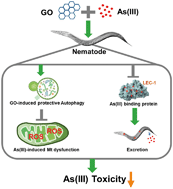Graphene oxide antagonizes the toxic response to arsenic via activation of protective autophagy and suppression of the arsenic-binding protein LEC-1 in Caenorhabditis elegans†
Abstract
Arsenic (As) pollution is a serious global problem and various technologies have been developed for As detoxification. Graphene oxide (GO) with its extraordinary structure and physicochemical properties has an excellent capability for the removal of As from contaminated water; however, the influence of GO on the toxic response to As(III), a well-established human carcinogen, is largely unknown. In the present study, Caenorhabditis elegans (C. elegans) was used as an in vivo model to clarify the role of GO at a non-toxic concentration in the toxic response to As(III) and its underlying molecular mechanisms. Our data showed that GO, irrespective of pretreatment or concurrent treatment with As(III), significantly blocked the toxic response to As(III). GO not only absorbed As(III), but also triggered protective autophagy, leading to efficient inhibition of oxidative stress, a major contributing factor in As(III) toxicity. Using laser ablation-inductively coupled plasma-mass spectrometry (LA-ICP-MS) and loss-of-function mutants, our data further showed that GO accelerated the excretion of As(III) from nematodes by suppressing the expression of As(III)-binding proteins LEC-1. Our data provided clear evidence that along with adsorption, the beneficial effects of GO in reducing As(III)-induced toxicity in vivo were mainly through protective autophagy coupled with downregulation of arsenic target protein expression, which might reveal new insights into the potential application of GO in water treatment and ecological risk assessment.

- This article is part of the themed collection: Environmental Science special collection celebrating Xiamen University’s Centenary


 Please wait while we load your content...
Please wait while we load your content...